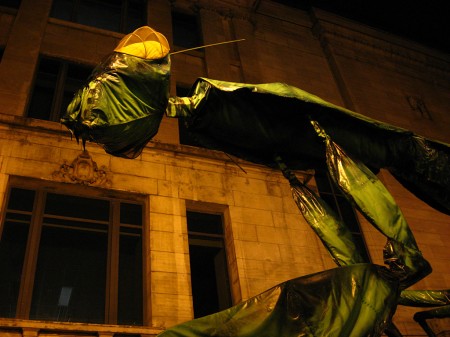
While sleeping off fever, I had a surprisingly coherent and well developed dream. If anyone wants to turn it into a Major Motion Picture Event, they can contact me about the rights.
It begins with a medium-sized dry cleaning shop in an American town dominated by a huge army base. The shop is struggling because the huge majority of the business comes from the armed forces, and it is all assigned through huge low-bid contracts. The owners decide that, small or not, they need to get into that system. Hoping to build some name recognition, at least, they decide to put in an a bid they feel sure will be higher than that of anyone else for the next thing to come up.
Meanwhile, some high ranking officers are discussing a problem. Due to a shipping problem, the dress uniforms of 1,000 soldiers returning from abroad have become soiled. (The film includes a shot of a non-waterproof cargo container sitting on the tarmac beside some jungle in the pouring rain. A mid-level officer has a muddy uniform half-pulled out and is shouting at someone more junior, though you cannot hear any of it through the rain.) They uniforms are needed clean for a big ceremony occurring in 24 hours. As a result, an urgent tender for contracts is posted on a government website.
Seeing the order, the dry cleaning shop owners decide that this is their chance to get noticed. They don’t have the resources to handle 1,000 uniforms in a day, but it’s not hugely beyond their capabilities. This is the kind of deal they want the military brass to consider them for. Not wanting to take on something they cannot handle, they bid $15,000,000 and leave it at that.
At computer terminals across the city, brief scenes show the big cleaning companies considering the contract and deciding it is too small to bother with. As a result, nobody else files a bid.
As a result, the small firm finds itself with a contract to clean 1,000 uniforms in 24 hours, for $15,000 each. Working flat out themselves, they are sure they can manage about 350. In the opportunity of a lifetime, they offer two other similarly sized companies the opportunity to clean 350 uniforms each for $10,000 a piece.
The portion involving the actual cleaning has your standard movie mixture of minor problems, clever solutions, and emotive demonstrations of why the various cleaners really need the money (to deal with higher interest mortgages, pay medical expenses, etc). At the last minute, the biggest truck owned by the dry cleaning firm breaks down, but, through a favour from the Hispanic army officer cousin of one of the owners, a big army truck comes by to collect the uniforms.
Sitting around celebrating with pizza and beer, the cleaners are surprised when a flashing message appears on the army requisition computer. For completing their contract on time and on budget, they are being given a 20% bonus.
One odd thing about my experience in dreaming the above is that the actual dream alternated between watching segments of the film which I had made in a room in my high school and walking around the building explaining various aspects to friends and acquaintances of mine. For instance, I was explaining to my friend Kate how, ideally, the film would work on two levels: as a feel-good story about an upstart out-maneuvering big competitors and winning a big reward and as a comment on the wastefulness of the armed forces. It would appear the the combination of influenza, NyQuil, and chocolate chunk cookies can have strange effects on the human subconscious.





